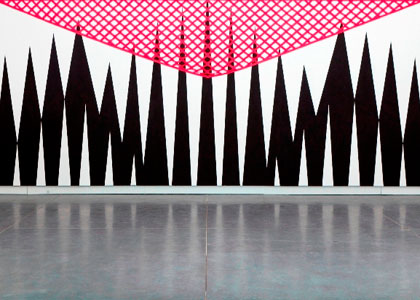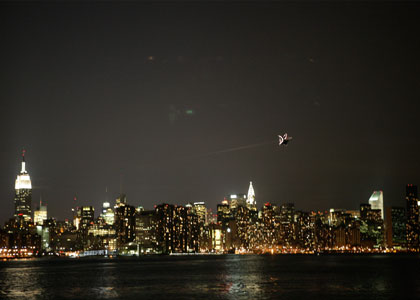Shesh Besh
Curator: Hadas Maor
24/03/2011 -
06/08/2011

The exhibition Shesh-Besh* brings together works in diverse media by young local artists who have emerged in the art scene during the past five/six years. The show is underlain by the desire to trace major features of young local practice, and mainly, the places where it displays a challenging use of familiar materials, ideas, and arenas while intrinsically shifting their meaning. Although it is not a thematic exhibition, most of the works make an educated use of various aspects of fabrication and crafting. Oscillating between the real and the imaginary, the sentimental and the conceptual, they create a mimetic, illusory world in which concepts of matter and space are intermittently undermined and consolidated.
At the entrance to the space, the viewer encounters Manhattan’s familiar skyline, with a star twinkling from time to time in the background—a work which marks a yearning of sorts, some undefined hope, perhaps even a promise. The transition to the central exhibition space is sharp. It is a cold, illuminated space with a concentration of structural works addressing notions of home and protection. External walls, delineated spaces, sealed bunkers, necessary ventilation means, and similar elements which
convey a sense of urgency, danger, or war. Juxtaposed with these works are three flagpoles, towering and at the same time bent, folding in on themselves, broken. The inner exhibition space and the additional extensions contain works of a slightly more playful nature, whether formally or conceptually.
Several thematic axes are thus outlined throughout the show: an ostensibly formalistic engagement, inclined toward the minimalistic, yet displaying local, personal, even physical aspects (Yael Efrati, Jumana Manna, Matan Ben-Tolila); engagement with the process and integration of movement and sound elements (Alona Rodeh, Naama Ben Yosef ); engagement with the notion of history while relating to its documentary dimension and the resulting perception of truth (Daniel Mann, Noga Inbar, Maya
Bloch); intentionally deceptive fluctuation between various material and mediumal dimensions (Peleg Dishon, Zachi Buchbut); conscious use of bare manipulation (Tom Pnini, Lior Modan); reference to existing cultural sources (Lea Golda Holterman,Tamar Harpaz, Nevet Yitshak).
Between political urgency and repression, the featured works transpire along a spectrum which, in many ways, parallels the local modi operandi and way of life: in the shadow of history and the given political situation, yet from an ostensibly universal perspective.
* Heb. for the game of backgammon, literally denoting the dice throw six-five.


















